Ref : Trumpeter #01582
Trumpeter #02047 TK-17 Pt-76 workable track links
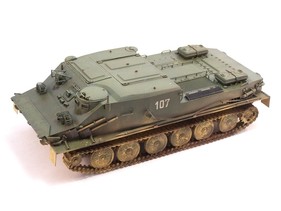

The BTR-50 is a variant of the PT-76 amphibious tank. It
underwent a period of trials between 1952 and 1954, it was
eventually accepted in service and the production started in 1954.
With the PT-76, it shares the same chassis,
running gear, engine and transmission as well as the same water-jet design system
at the rear. Initially the massive superstructure was open which meant that the
up to twenty troops were not protected against the NBC threat.
The mounted soldiers could fire from two ports on the sides. A 7.62mm MG was mounted on a pintle in front of the troop compartment. On the early BTR-50P version, folding ramps were fitted to allow the loading of an anti-tank gun.
The waterjets and the trim vane enable the BTR-50 to
swim but the freeboard of 15 to 20 cm only limited this capacity to rather
calm waters.
The NBC environment in which the Soviet Army expected to be committed led to
modify the BTR-50 with the addition of a roof and a ventilation system. From
1958, this new BTR-50 entered service under the denomination of BTR-50PK. Unlike
for many other Soviet vehicles, the K stands for roof in Russian and does not
indicate a command version.
The BTR-50PK has been in service with a large number of armies of the Warsaw Pact but also in the Middle-East, Africa, Asia and South America. It saw action in various wars in particular those between Israel and the Arab states.
The kit
After the release of
the PT-76, it was logical that Trumpeter releases this APC. The model comes in a
sturdy cardboard box with an inner compartment to protect the hull halves. In
the box, there are 4 light grey plastic sprues, the upper and lower hull, a
sheet of photoetched parts, a sheet of decals, a set of soft plastic tracks, a
bit of string and the instructions.
The sprues are wrapped in several plastic bags and some fine parts are protected
by a bit of foam.
The molding is
correct even in some areas the lines are a bit thick. The level of detail is
satisfactory. The kit tracks are right but simplified, the guide teeth being
flat. They are replaced by the individual links tracks for PT-76 of Trumpeter.
The antenna base is wrong at least for a vehicle of the Warsaw Pact. It looks
like Trumpeter used as reference pictures of vehicles captured by the Israeli
army.
The instructions come in a 8 page booklet plus a color sheet for the camouflage schemes.
The assembly
It is divided into 11 steps according to the instructions and begins by the running gear as usual. The road wheels are in two parts. Trumpeter molded one of them with the full rubber band. Unfortunately this does not prevent from sanding the molding line. It also is necessary to thin down the lines on the rubber band. The positioning pin of the outer face of the sprocket must be deleted. The alignment between the both parts is done with the track.
As I decided to use the set of individual links tracks, I started by gluing the two guide teeth on each link then the links are clicked together. Some pins are damaged by the process and the tracks tend to fall apart. So it will be necessary to glue them. In the same time, I noticed that the tracks were too short. About 6 links per track are missing. To fix this issue, I cut a bit of the kit track and glue it to the sprocket to hide the different guide teeth. The bondage between those links and the individual links is done with CA glue. Unlike what I'm used to do, I glue the whole running gear to the tracks.
Then the hull is assembled before adding the various parts. This allows to note that the upper hull is too short by 1 mm. A strip of plastic is glued at the rear of the engine deck.
The fit of the engine plates F3 and F10 is not perfect. The PE grill PE-1 must be trimmed as it is too large.
At the step 7, the front cable hooks E9 must be glued in the foremost hole contrarily to the drawing. The wrong hole is intended to glue the towing eye of the cable. For a better realism, it is filled.
At the step 8, the antenna bas is replaced by a Russian type coming from the spare box. The PE headlight protections are not used. They are too large and do not match the actual type. New protections are made from brass wire. On the right side protection, I mistakenly put 4 vertical bars instead of 5. The rubber mud flaps are thinned. The towing cable locks A15 are glued after the cables are hooked in place.
The decoration
The decal sheet enables to represent an East-German or a Russian vehicle. Trumpeter provides individual white numbers which allows to make personalized markings. Apart the Guard emblem, no other unit symbol is provided.
The base paint is Tamiya XF-67 NATO green. On top of the vehicle, it is enlightened to create a light zenithal effect. The weathering is done by drawing oil dots downward. A dark brown wash is applied to enhanced the details. A first dust effect is created by applying various pigment shades. The excess is brushed away in particular on the road wheels. Some fixative in spray is used then a new coat of pigments is applied.
Click on a thumbnail to see the full sized picture
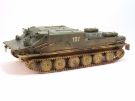
|
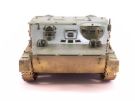
|
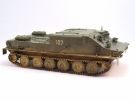
|
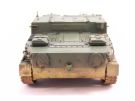
|
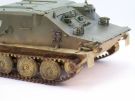
|
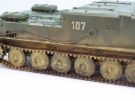
|
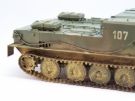
|
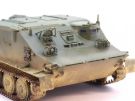
|
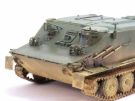
|
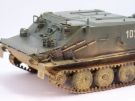
|
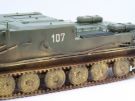
|
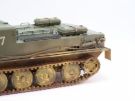
|
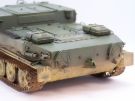
|
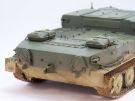
|
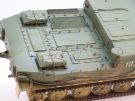
|
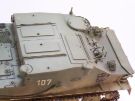
|
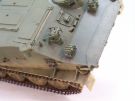
|
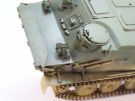
|
||